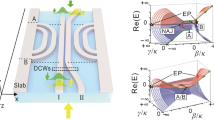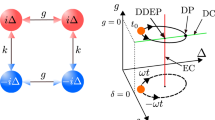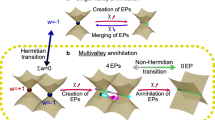Abstract
The adiabatic theorem, a corollary of the Schrödinger equation, manifests itself in a profoundly different way in non-Hermitian arrangements, resulting in counterintuitive state transfer schemes that have no counterpart in closed quantum systems. In particular, the dynamical encirclement of exceptional points (EPs) in parameter space has been shown to lead to a chiral phase accumulation, non-adiabatic jumps and topological mode conversion1,2,3,4,5,6,7,8. Recent theoretical studies, however, have shown that contrary to previously established demonstrations, this behaviour is not strictly a result of winding around a non-Hermitian degeneracy9. Instead, it seems to be mostly attributed to the non-trivial landscape of the Riemann surfaces, sometimes because of the presence of an EP in the vicinity9,10,11. Here, in an effort to bring this counterintuitive aspect of non-Hermitian systems to light and confirm this hypothesis, we provide a set of experiments to directly observe the field evolution and chiral state conversion in an EP-excluding cycle in a slowly varying non-Hermitian system. To do so, a versatile yet unique fibre-based photonic emulator is realized that utilizes the polarization degrees of freedom in a quasi-common-path single-ring arrangement. Our observations may open up new avenues for light manipulation and state conversion, as well as providing a foundation for understanding the intricacies of the adiabatic theorem in non-Hermitian systems.
This is a preview of subscription content, access via your institution
Access options
Access Nature and 54 other Nature Portfolio journals
Get Nature+, our best-value online-access subscription
$29.99 / 30 days
cancel any time
Subscribe to this journal
Receive 51 print issues and online access
$199.00 per year
only $3.90 per issue
Buy this article
- Purchase on Springer Link
- Instant access to full article PDF
Prices may be subject to local taxes which are calculated during checkout




Similar content being viewed by others
Data availability
All data that support the findings of this study are available within the paper and the Supplementary Information and are available from the corresponding author upon request.
References
Uzdin, R., Mailybaev, A. & Moiseyev, N. On the observability and asymmetry of adiabatic state flips generated by exceptional points. J. Phys. A 44, 435302 (2011).
Graefe, E.-M., Mailybaev, A. A. & Moiseyev, N. Breakdown of adiabatic transfer of light in waveguides in the presence of absorption. Phys. Rev. A 88, 033842 (2013).
Gilary, I., Mailybaev, A. A. & Moiseyev, N. Time-asymmetric quantum-state-exchange mechanism. Phys. Rev. A 88, 010102 (2013).
Doppler, J. et al. Dynamically encircling an exceptional point for asymmetric mode switching. Nature 537, 76–79 (2016).
Xu, H., Mason, D., Jiang, L. & Harris, J. G. Topological energy transfer in an optomechanical system with exceptional points. Nature 537, 80–83 (2016).
Yoon, J. W. et al. Time-asymmetric loop around an exceptional point over the full optical communications band. Nature 562, 86–90 (2018).
Hassan, A. U., Zhen, B., Soljačić, M., Khajavikhan, M. & Christodoulides, D. N. Dynamically encircling exceptional points: exact evolution and polarization state conversion. Phys. Rev. Lett. 118, 093002 (2017).
Zhang, X.-L. & Chan, C. T. Dynamically encircling exceptional points in a three-mode waveguide system. Commun. Phys. 2, 63 (2019).
Hassan, A. U. et al. Chiral state conversion without encircling an exceptional point. Phys. Rev. A 96, 052129 (2017).
Zhong, Q., Khajavikhan, M., Christodoulides, D. N. & El-Ganainy, R. Winding around non-Hermitian singularities. Nat. Commun. 9, 4808 (2018).
Feilhauer, J. et al. Encircling exceptional points as a non-Hermitian extension of rapid adiabatic passage. Phys. Rev. A 102, 040201 (2020).
Kato, T. Perturbation Theory for Linear Operators (Springer, 2013).
Heiss, W. D. Phases of wave functions and level repulsion. Eur. Phys. J. D 7, 1–4 (1999).
Moiseyev, N. Non-Hermitian Quantum Mechanics (Cambridge Univ. Press, 2011).
El-Ganainy, R. et al. Non-Hermitian physics and PT symmetry. Nat. Phys. 14, 11–19 (2018).
Parto, M., Liu, Y. G. N., Bahari, B., Khajavikhan, M. & Christodoulides, D. N. Non-Hermitian and topological photonics: optics at an exceptional point. Nanophotonics 10, 403–423 (2021).
Makris, K. G., El-Ganainy, R., Christodoulides, D. N. & Musslimani, Z. H. Beam dynamics in PT symmetric optical lattices. Phys. Rev. Lett. 100, 103904 (2008).
Klaiman, S., Günther, U. & Moiseyev, N. Visualization of branch points in PT-symmetric waveguides. Phys. Rev. Lett. 101, 080402 (2008).
Zheng, M. C., Christodoulides, D. N., Fleischmann, R. & Kottos, T. PT optical lattices and universality in beam dynamics. Phys. Rev. A 82, 010103 (2010).
Milburn, T. J. et al. General description of quasiadiabatic dynamical phenomena near exceptional points. Phys. Rev. A 92, 052124 (2015).
Zhang, X.-L., Wang, S., Hou, B. & Chan, C. T. Dynamically encircling exceptional points: in situ control of encircling loops and the role of the starting point. Phys. Rev. X 8, 021066 (2018).
Zhang, X.-L., Jiang, T. & Chan, C. T. Dynamically encircling an exceptional point in anti-parity-time symmetric systems: asymmetric mode switching for symmetry-broken modes. Light Sci. Appl. 8, 88 (2019).
Choi, Y., Hahn, C., Yoon, J. W., Song, S. H. & Berini, P. Extremely broadband, on-chip optical nonreciprocity enabled by mimicking nonlinear anti-adiabatic quantum jumps near exceptional points. Nat. Commun. 8, 14154 (2017).
Choi, Y., Yoon, J. W., Hong, J. K., Ryu, Y. & Song, S. H. Direct observation of time-asymmetric breakdown of the standard adiabaticity around an exceptional point. Commun. Phys. 3, 140 (2020).
Gao, T. et al. Observation of non-Hermitian degeneracies in a chaotic exciton-polariton billiard. Nature 526, 554–558 (2015).
Dembowski, C. et al. Experimental observation of the topological structure of exceptional points. Phys. Rev. Lett. 86, 787 (2001).
Mailybaev, A. A., Kirillov, O. N. & Seyranian, A. P. Geometric phase around exceptional points. Phys. Rev. A 72, 014104 (2005).
Heiss, W. D. The physics of exceptional points. J. Phys. A 45, 444016 (2012).
Dembowski, C. et al. Encircling an exceptional point. Phys. Rev. E 69, 056216 (2004).
Liu, Q., Liu, J., Zhao, D. & Wang, B. On-chip experiment for chiral mode transfer without enclosing an exceptional point. Phys. Rev. A 103, 023531 (2021).
Berry, M. V. & Uzdin, R. Slow non-Hermitian cycling: exact solutions and the Stokes phenomenon. J. Phys. A 44, 435303 (2011).
Acknowledgements
We gratefully acknowledge the financial support from the Air Force Office of Scientific Research (Multidisciplinary University Research Initiative (MURI) Award on Novel light-matter interactions in topologically non-trivial Weyl semimetal structures and systems: FA9550-20-1-0322, MURI Award on Programmable systems with non-Hermitian quantum dynamics: FA9550-21-1-0202), DARPA (D18AP00058), the Office of Naval Research (N00014-19-1-2052, N00014-20-1-2522, MURI Award on Classical entanglement in structured optical fields: N00014-20-1-2789), the Army Research Office (W911NF-17-1-0481), the National Science Foundation (DMR-1420620, EECS-1711230, ECCS CBET 1805200, ECCS 2000538, ECCS 2011171), the W. M. Keck Foundation, the US–Israel Binational Science Foundation (BSF; 2016381), the MPS Simons collaboration (Simons grant 733682), the US Air Force Research Laboratory (FA86511820019), the Austrian Science Fund (FWF, P32300 WAVELAND) and European Commission grant MSCA-RISE 691209. G.L-G. acknowledges support from Consejo Nacional de Ciencia y Tecnologia (CONACyT). We thank A. Turchanin and U. Peschel from Friedrich Schiller University Jena for useful discussions and feedback.
Author information
Authors and Affiliations
Contributions
D.N.C. and M.K. conceived the idea. H.N., G.L.-G. and H.E.L.-A. designed and performed the experiments in consultation with other team members. H.N., A.U.H. and A.S. performed the analysis with help from other members. H.N., M.K. and D.N.C. wrote the manuscript with help from all the authors.
Corresponding author
Ethics declarations
Competing interests
The authors declare no competing interests.
Peer review
Peer review information
Nature thanks Jae Woong Yoon and the other, anonymous, reviewer(s) for their contribution to the peer review of this work.
Additional information
Publisher’s note Springer Nature remains neutral with regard to jurisdictional claims in published maps and institutional affiliations.
Supplementary information
Supplementary Information
This file contains Supplementary text, figures and references.
Rights and permissions
About this article
Cite this article
Nasari, H., Lopez-Galmiche, G., Lopez-Aviles, H.E. et al. Observation of chiral state transfer without encircling an exceptional point. Nature 605, 256–261 (2022). https://doi.org/10.1038/s41586-022-04542-2
Received:
Accepted:
Published:
Issue Date:
DOI: https://doi.org/10.1038/s41586-022-04542-2
This article is cited by
-
Chiral transmission by an open evolution trajectory in a non-Hermitian system
Light: Science & Applications (2024)
-
Exceptional points and non-Hermitian photonics at the nanoscale
Nature Nanotechnology (2023)
-
Dynamically crossing diabolic points while encircling exceptional curves: A programmable symmetric-asymmetric multimode switch
Nature Communications (2023)
-
Non-Hermitian chiral degeneracy of gated graphene metasurfaces
Light: Science & Applications (2023)
-
Higher-order singularities in phase-tracked electromechanical oscillators
Nature Communications (2023)
Comments
By submitting a comment you agree to abide by our Terms and Community Guidelines. If you find something abusive or that does not comply with our terms or guidelines please flag it as inappropriate.



